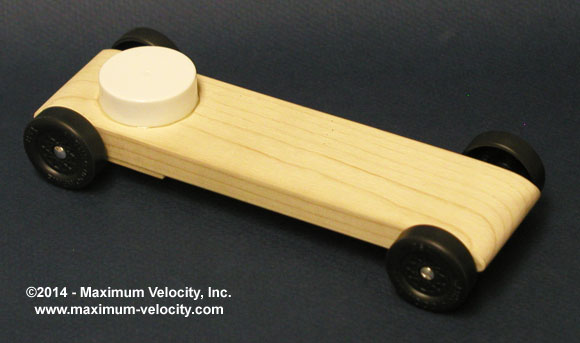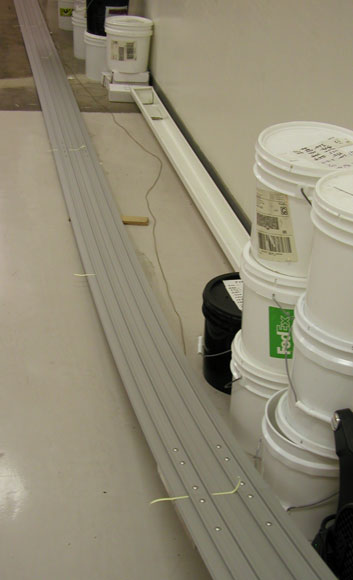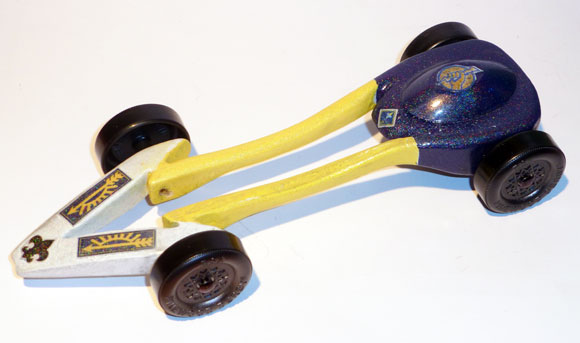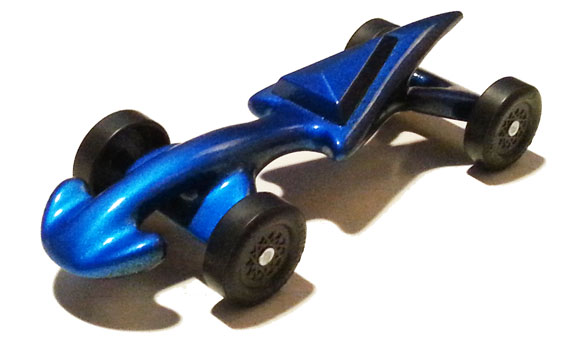– Feature Article – Height of Ballast Weight Vs. Performance: Part 2
– Humor
– Pinewood Derby Car Showcase
– Q&A
Feature Article
Height of Ballast Weight Vs. Performance – Part 2
By Randy Davis
Last season, I ran an experiment and published an article on the effect of the height of the ballast weight on performance (Volume 13, Issue 9 – Height of Ballast Weight Versus Performance).
That experiment showed that for a reasonable (9/16 inch) variance in the height of the ballast weight, there was no measurable effect on performance.
After the article was published, I received quite a bit of feedback claiming that the experiment was under ideal conditions so it could not be applied to real racing.
Truly, the test was done under as ideal conditions as possible, as I wanted to ensure that any variance in performance was due to the height of the weight and not some other factor. For example, outlaw (disk) wheels were used to minimize friction, and the track was very smooth.
So, to address the feedback I determined to run the test again with the following changes:
- BSA Wheels and Axles instead of Outlaw Wheels – these wheels have more track surface contact, and the wheel/axle fit is sloppy.
- Rougher track
Experiment Setup
The same car was used as in the original experiment (see Figures 1 and 2). Of course the wheels/axles were swapped out; Pro-Stock BSA Speed Wheels and BSA Speed Axles were used and lubed with Krytox 100 lube.
Figure 1 – Top of Test Car
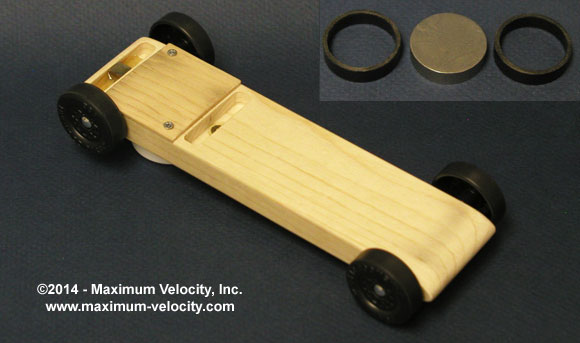
As a recap, the car has a 1-3/8 inch hole drilled completely through the car, and a medicine bottle cap with a 1-3/8 inch internal diameter is glued over the hole. The resulting cavity can hold a 3.25 ounce tungsten round (9/32 inch thick) and two hollow plastic spacers (same OD and thickness), and a thin plastic shim to prevent rattling. On the bottom of the car, the hole is covered with a removable plate (shown in Figure 2). Additional ballast weight was added to bring the car up to five ounces.
To add “roughness” to the track, strips of Post-it material was applied to the track. At each track joint, a strip was placed on both sides of the center guide rail. At the half-way point of each track section, a strip was placed on one side of the rail (alternating sides down the track). When the car raced, it made a pleasing clickety-clack train track sound.
Figure 3 – Post-it Strips on Track
The experiment started with the tungsten round at the bottom and the two spacers on the top. Three heats were run with this configuration. Then the plate was removed, the round placed between the spacers, and the plate replaced. After three heats with this configuration, the round was placed above the two spacers, and six heats were run. Then the configuration was changed back to the round in the middle for three heats, followed by the round at the bottom for the final three heats. Thus, six heats were run for each configuration.
Experimental Results
Other than the car being a little slower than in the original experiment, nothing else changed. The car was still very consistent, and performed the same regardless of the height of the weight.
2.5308 Sec – Low COG Average
2.5297 Sec – Middle COG Average
2.5305 Sec – High COG Average
0.0016 Sec – Standard Deviation
The greatest difference in average times (between the low and middle COG was 1.1 milliseconds which was less than the standard deviation of the data, so the difference is statistically insignificant.
Conclusion
Thus, the same conclusion can be drawn as in the original experiment: within reason (9/16 inch for this experiment) don’t worry about the height of the COG. Certainly get the COG towards the back, keep your car aerodynamically sleek, and have fun designing your car. If you want to use a tungsten canopy, certainly don’t be afraid to do so.
Humor
Darth Vader and Luke Skywalker were having a long drawn out duel on Christmas Eve. Lightsabers drawn and sparks flying Vader pinned Luke against a bulkhead and glared at him.
“I know what you’re getting for Christmas, Luke,” he said, “Ohhh, yes! I know!” Luke fought himself free and jumped to a higher platform just out of Vader’s reach.
“How do you know!?” Luke yelled at him, “How do you know what I’m getting for Christmas!?”
Darth Vader snarled, “The force is strong with me… I felt your presents.”
Pinewood Derby Car Showcase
Arrow of Lightening – Scott & Derek Bobbitt
For his final foray in pinewood derby racing, my son Derek opted to showcase Scout Spirit and go for the “Lord Baden Powell” award for most Cub Spirit. His entry, the “Arrow of Lightening” succeeded. He won the Cub Spirit award and placed first out the 30 entries in the pack. At the district finals, five cars from each Pack were invited to participate. The “Arrow of Lightening” won every heat and placed second overall by just 0.007 seconds! Most importantly, though, his car won the District award for “Best-In-Show”. He was one elated Webelos!
Triangulator – Gerald Scotting
After seeing the unusual triangular tungsten canopy I knew i wanted to design a car around it. The canopy made up most of the weight for the car, but due to the super slim design I was still too light. I ended up using a bunch of the 3/16″ tungsten beads. The body was cut out as a side profile, then a rough top profile. All other shaping was done with either a round file or sandpaper, and lots of patience.
Q&A
Two questions (actually three):
- When drilling axle holes is it 1/8 inch from the bottom, and then 1/16 inch higher for the raised wheel)?
- To set up alignment for rail-riding, do I first adjust in a straight line so the wheels do not move in or out, and then set the pull; or do I set the pull and then adjust the wheels in back to not move in or out? Also, is 4 inches over 8 feet the correct amount of drift?
Three Answers:
- Yes, I drill at 1/8 inch, and then 3/16 inch for the raised wheel. This is not hard and fast. You can go a little higher or lower. Just make sure to maintain the 3/8 inch ground clearance.
- First, you want to adjust the rear axles so that wheels stay on the axle heads regardless of the car direction (forward or backward). Then set the drift with the front dominant wheel.
- I recommend 5 inches over 8 feet. For a very aggressive COG, you may need more drift to maintain stability.
I recently purchased a car kit. When I received it, it appears that the holes are drilled higher than the axle slots on the standard BSA blocks. I am concerned that the car will not clear the center guide rail. Do the drilled holes lower the car clearance too much?
When wheels/axles are mounted on a BSA block, the clearance is over 1/2 inch. The specification is 3/8 inch minimum, so there is over 1/8 inch of extra clearance.
When we drill axle holes, the axles are 1/16 inch higher on the block, which lowers the body by 1/16 inch. This reduces the clearance, but the clearance is still greater than 3/8 inch. You can temporarily mount the wheels/axles and measure this for yourself.
The only concern is to make sure that axle holes are allowed by your local rules. Some scout packs require you to use the original axle slots. Certainly check your local rules to make sure axle holes are allowed.
Want Answers?
Do you have a pinewood derby-related question? If so, e-mail us your question.We answer all questions by e-mail, but not every question will appear in the Q&A section of the newsletter.
Back Issues
Are you a new subscriber, or have you missed some of the previous newsletters? Don’t miss out; all of the issues for Volume 5 through Volume 17 are posted on our web site.
Newsletter Contributions
We welcome your contributions. If you would like to contribute an article, a web site review, a speed tip, or a pinewood derby memory, please e-mail us.
Subscription Information
The Pinewood Derby Times is a free e-newsletter focused on pinewood derby racing. It is published biweekly from October through March.
If you haven’t already done so, please forward this issue to your pinewood derby friends. But please don’t subscribe your friends. Let them decide for themselves. Thanks.
If this newsletter was forwarded to you, why not subscribe to receive this newsletter. There is no cost, and your e-mail address is safe, as we never sell or share our distribution list.
To subscribe, send a blank e-mail to
pi*********************@*******st.com
You will receive a confirmation e-mail. Reply to the confirmation e-mail and you will start receiving the Pinewood Derby Times with the next issue.
Randy Davis, Editor, Pinewood Derby Times
E-Mail: in**@**************ty.com
(C)2018, Maximum Velocity, Inc. All rights reserved. Please do not reprint or place this newsletter on your web site without explicit permission. However, if you like this newsletter we grant permission, and encourage you to e-mail it to a friend.
Maximum Velocity disclaims any personal loss or liability caused by utilization of any information presented in this newsletter.
The Pinewood Derby Times is not specific to, and is not affiliated with the Boy Scouts of America, YMCA, Awana, or any other organization.
(R)Maximum Velocity is a registered trademark of Maximum Velocity, Inc.
(R)Pinewood Derby is a registered trademarks of the Boys Scouts of America.
(R)Awana is a registered trademark of Awana Clubs International.
All other names are trademarks of their respective owners.

